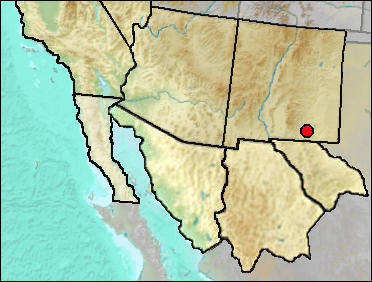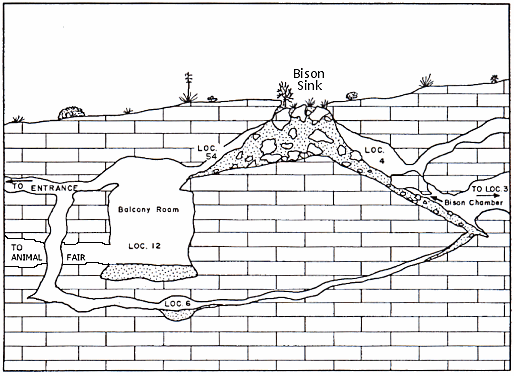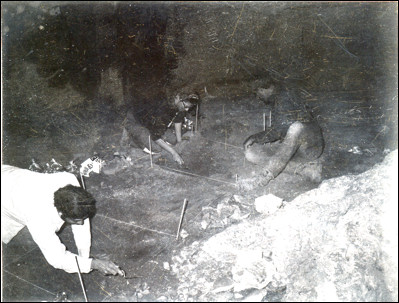 Age. Late Wisconsin.
Age. Late Wisconsin.
General Description. A Dry Cave site (UTEP 12). The site consists of deposits on floor of Balcony Room. Sources are Bison Sink (via UTEP 54), the modern entrance, and possibly Animal Fair (UTEP 22). Most material except on surface and, possibly, under entrance tunnel overhang, are late Wisconsin. Harris (1993b) estimated that the third 10-cm level was roughly about 12,000 radiocarbon years old.
Discussion.  There are several possible sources
for the fossil material (Fig. 1). Undoubtedly, material from the now-closed Bison Sink forms the
bulk of the fill. However, some material potentially is from the Entrance passage and from the
Animal Fair site. Some fresh plant material occurred below the lip of the Entrance passage,
apparently carried in by storm waters; it seems unlikely that much generally heavier faunal
material would have been washed in. However, it is quite likely that animals lost or incautious
would fall into the sink on occasion. The Animal Fair fissure openings are distant enough from
Balcony Room that only the smallest and lightest of faunal material is likely to have washed from
that area.
There are several possible sources
for the fossil material (Fig. 1). Undoubtedly, material from the now-closed Bison Sink forms the
bulk of the fill. However, some material potentially is from the Entrance passage and from the
Animal Fair site. Some fresh plant material occurred below the lip of the Entrance passage,
apparently carried in by storm waters; it seems unlikely that much generally heavier faunal
material would have been washed in. However, it is quite likely that animals lost or incautious
would fall into the sink on occasion. The Animal Fair fissure openings are distant enough from
Balcony Room that only the smallest and lightest of faunal material is likely to have washed from
that area.
Fig. 1. Sketch of the vertical relationships of several sites in the vicinity of the now-closed Bison Sink. Adapted from Harris (1970).
Locality 54 consists of material deposited from Bison Sink and has a 14C date on bone collagen of 10,730 ± 150 (I-6200). Except for possible late material entering from the entrance area, the bulk of the material in Balcony Room originated from Bison Sink and must be older than that date. Faunalistically, UTEP 54 is latest Pleistocene.
In general, the fauna is a good late Wisconsin assortment. However, it's not clear whether late Pleistocene warming is indicated in the uppermost levels or whether presence of such warm-climate taxa as Sigmodon hispidus, a whiptail lizard (Aspidoscelis), and a small kangaroo rat is indicative of intermixed Holocene elements. A relatively heavy concentration of bones in the uppermost levels suggests a decreased rate of sedimentation with a nearly stable surface adding Holocene elements to those of the latest Wisconsin. Thus the tentatively identified Eastern Cottontail rabbit may be from a Holocene westward movement of eastern prairie species similar to that interpreted from Holocene material in the Isleta Caves.
Some insight into the late Wisconsin environment is given by the proportions of various kinds of voles. Five species are present in the site, with 148 specimens identified to the species level. Percentages of the identified species are as follows: Mogollon Vole (Microtus mogollonensis), 43%; Sagebrush Vole (Lemmiscus curtatus), 37%; Meadow Vole (Microtus pennsylvanicus), 13%; Prairie Vole (Microtus ochrognathus), 5%; and Long-tailed Vole (Microtus longicaudus), 2%.

Fig. 2. South end of Trench I, Balcony Room. Left to right: Charlie Berg, Patricia Hurley, and Howard McDonald. Photograph taken in June 1970 by A. H. Harris.
The Mogollon Vole today inhabits the grassy understory of relatively arid woodland and open coniferous forest, while the Sagebrush Vole commonly lives in Big Sagebrush-Grassland habitat. It seems likely that the deeper soils of interfluves supported the latter, while valley slopes and thinner soils supported habitat for the Mogollon Vole. In the Southwest, Meadow Voles tend to inhabit sedge beds and other relatively thick streamside cover, suggesting sufficient moisture to maintain such an environment in nearby minor drainageways. The Prairie Vole, living up to its name, likely inhabited areas of purer grassland, rather than the shrub-grassland of the Sagebrush Vole. The Long-tailed Vole demands a somewhat more mesic environment than the other upland voles, possibly living on cool north-facing slopes or perhaps more likely representing raptor prey from the Guadalupe Highlands to the west. The Long-tailed Vole was more common in Dry Cave's Locality 6 (14%), with a date of 14,470, and in the Dry Cave Locality 22's near-full-glacial deposits earlier than 15 ka (14%), indicating a nearer source than that of the Balcony Room fauna.
Osteichthyes—Bony Fishes
Ambystoma mavortium—Barred Tiger Salamander
Spea bombifrons—Plains Spadefoot
Holman (1970) identified two ilia and one sacro-urostyle to this species; Applegarth (1979) indicated they were identifiable only to genus (before the split of Scaphiopus into Scaphiopus and Spea).
Anaxyrus punctatus—Red-spotted Toad
Pseudacris triseriata—Midland Chorus Frog
Crotaphytus collaris—Eastern Collared Lizard
Phrynosoma hernandesi—Mountain Horned Lizard
Sceloporus cowlesi—Southern Plateau Lizard
Aspidoscelis sp.—Whiptail Lizards
Presence is based on a single specimen from the uppermost level and likely is Holocene.
Bogertophis subocularis—Trans-Pecos Rat Snake
Coluber/Masticophis—Racers, Whip Snakes
Lampropeltis getula—Common Kingsnake (cf.)
Pituophis catenifer—Gopher Snake
Salvadora sp.—Patchnose Snakes (cf.)
Crotalus atrox—Western Diamondback Rattlesnake
Identification was by J. Alan Holman, based on a right articular. Crotalus vertebrae are virtually ubiquitous in the deposits.
Hypsiglena sp.—Night Snakes (cf.)
Thamnophis sp.—Garter Snakes
Anas sp.—Ducks
Cathartes aura—Turkey Vulture
The single specimen (an ulna) was found on the surface of a ledge and probably is Holocene.
Coragyps occidentalis—Western Vulture
Aquila chrysaetos—Golden Eagle
Caracara cheriway—Crested Caracara
Asio flammeus—Short-eared Owl
Colaptes auratus—Northern Flicker
Eremophila alpestris—Horned Lark
Corvus corax—Common Raven
Sialia sp.—Bluebirds
? Vireonidae—Vireos
Quiscalus—Grackles
Ictidomys tridecemlineatus—Thirteen-lined Ground Squirrel (cf.)
Marmota flaviventris—Yellow-bellied Marmot
Urocitellus elegans—Wyoming Ground Squirrel
Xerospermophilus spilosoma—Spotted Ground Squirrel (cf.)
Chaetodipus hispidus—Hispid Pocket Mouse
Dipodomys merriami/ordii—Merriam's or Ord's Kangaroo Rat
Two specimens of a kangaroo rat smaller than D. spectabilis were recovered from level 2 of the excavations and are judged as likely Holocene.
Dipodomys spectabilis—Banner-tailed Kangaroo Rat
Cratogeomys castanops—Yellow-faced Pocket Gopher
Thomomys bottae—Botta's Pocket Gopher
Thomomys talpoides—Northern Pocket Gopher
Lemmiscus curtatus—Sagebrush Vole
Microtus longicaudus—Long-tailed Vole
Microtus mogollonensis—Mogollon Vole
Microtus ochrogaster—Prairie Vole
Microtus pennsylvanicus—Meadow Vole
Neotoma cinerea—Bushy-tailed Woodrat
Neotoma leucodon—White-toothed Woodrat
Neotoma mexicana—Mexican Woodrat
Neotoma micropus—Southern Plains Woodrat
Onychomys leucogaster—Northern Grasshopper Mouse
Peromyscus maniculatus—Deer Mouse
Reithrodontomys sp.—Harvest Mice
Sigmodon hispidus—Hispid Cotton Rat
Erethizon dorsata—American Porcupine
Lepus townsendii—White-tailed Jackrabbit (cf.)
Sylvilagus audubonii—Desert Cottontail
Sylvilagus floridanus—Eastern Cottontail (cf.)
Sylvilagus nuttallii—Mountain Cottontail
Cryptotis parva—Least Shrew
Notiosorex dalquesti—Dalquest's Shrew (Carraway 2010)
Sorex merriami—Merriam's Shrew
Sorex neomexicanus—New Mexico Shrew
Tadarida brasiliensis—Mexican Free-tailed Bat
Corynorhinus sp.—Big-eared Bats
Eptesicus fuscus—Big Brown Bat
Lasiurus sp.—Lasiurine Bats
Myotis velifer—Cave Myotis
Lynx rufus—Bobcat
Canis sp.—Wolves (cf.)
Identification is based on an exoccipital.
Vulpes velox—Swift Fox
Ursus—Bears (?)
Mustela erminea—Ermine
Mephitis mephitis—Striped Skunk
†Equus conversidens—Mexican Horse
†Equus francisci—Stilt-legged Horse
†Equus niobrarensis—Niobrara Horse
†Equus occidentalis—Western Horse (?)
†Stockoceros conklingi—Conkling's Pronghorn
Harris (1993c) reported as Cf. Capromeryx.
Bison sp.—Bison
Literature. Carraway 2010; Harris 1970a; Harris 1993b, 1993c; Holman 1970.
Last Update: 19 Feb 2015